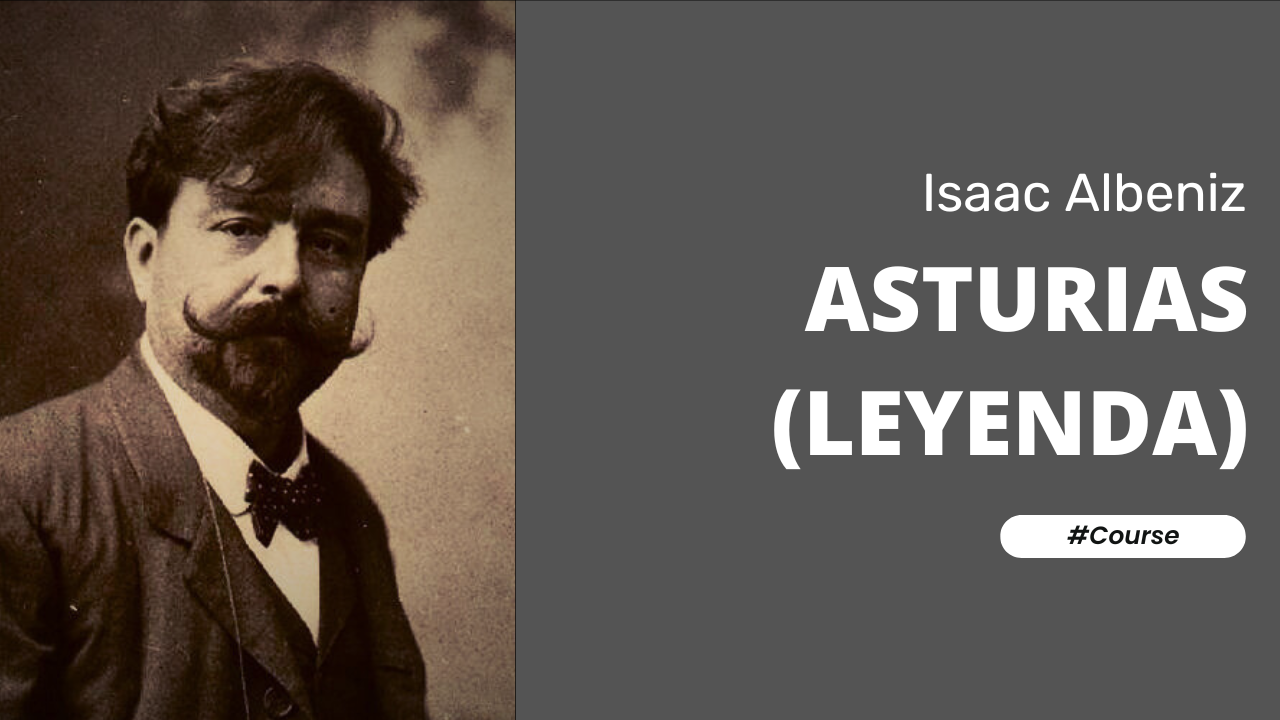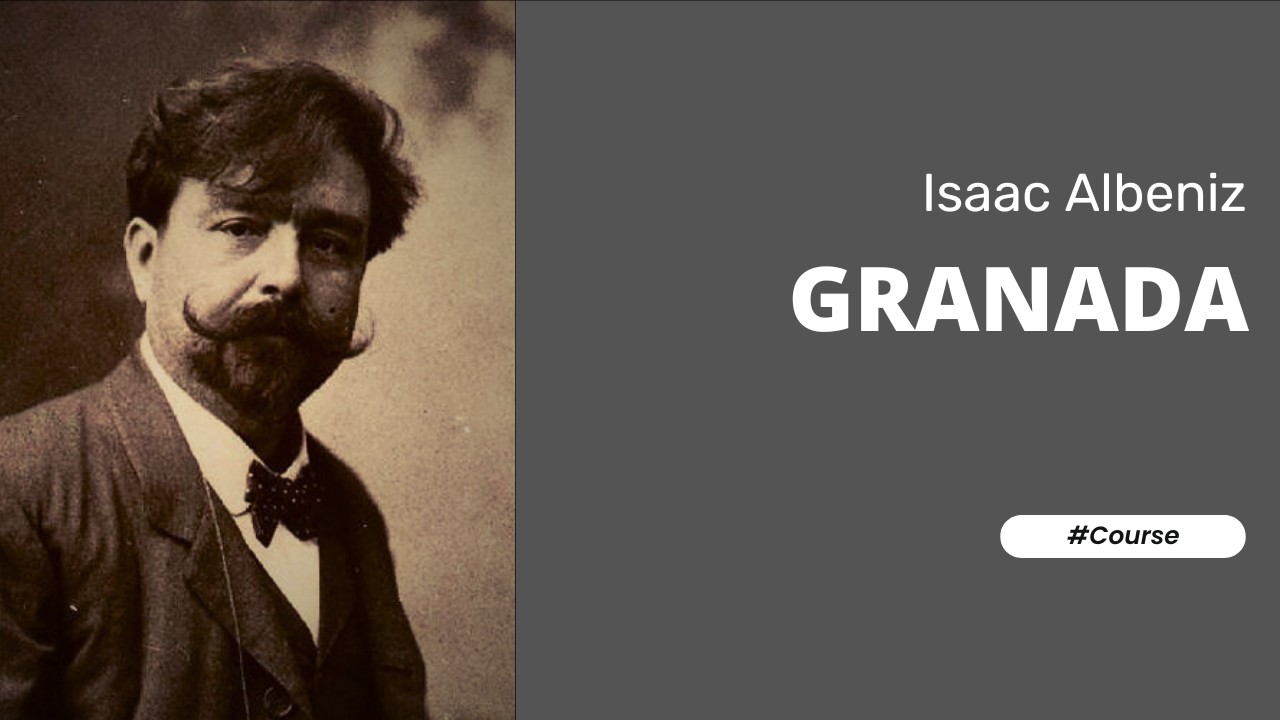Pavana Capricho by Isaac Albeniz
Introduction
“Pavana Capricho” is a piece I stumbled across recently as I was browsing through various YouTube videos. The introduction with a sustained trill whilst playing artificial harmonics with the right hand captured me in the first few seconds and from that point I knew I had to transcribe it, learn it, and make lessons!
This pavana is a perfect fusion of Spanish folk music and classical forms for which Albéniz is renowned. Originally composed for piano, this piece has been effectively transcribed for classical guitar, highlighting the instrument’s expressive capabilities. “Pavana Capricho” is typically set in the key of E minor (however here it has been transcribed to D minor), and it is performed at a moderate tempo that allows the melodic lines and intricate harmonies to unfold gracefully. The piece does not feature key changes or modulations, maintaining a consistent tonal center that provides a clear, cohesive structure. The pavana, a slow processional dance, is evident in the stately rhythm and elegant phrasing, while the capricho, or caprice, allows for moments of virtuosic flair and improvisatory elements.
Performing “Pavana Capricho” on classical guitar requires a delicate touch and a few. big stretches! The guitarist must navigate the piece’s arpeggiated passages and ornamental flourishes with precision, ensuring that each note resonates with clarity and emotion. I find the section with the diminished arpeggios benefits from nice crescendos, gradually building to the piece’s climax.
Below are some of my suggestions:
-
Make sure you can do artificial harmonics well before attempting the opening bars
-
Crescendo the D minor arpeggios
-
Use the thumb to strum the chords in the C section emphasising the melodic line only
-
Use lots of tonal colours to avoid monotony
Musical Style
Isaac Albéniz’s musical style is characterized by its rich harmonic language, vibrant rhythms, and evocative melodies that draw heavily on Spanish folk traditions. His compositions often incorporate elements of flamenco, Andalusian scales, and traditional Spanish dances, creating a distinctive and authentic sound. Albéniz’s works are known for their technical complexity and expressive depth, requiring both virtuosity and sensitivity from the performer. His ability to blend folkloric elements with classical structures has made his music enduringly popular and influential in the classical guitar repertoire.
Notable Pieces
Five notable pieces by Isaac Albéniz:
• Asturias (Leyenda)
• Cádiz (from Suite Española, Op. 47)
• Granada (from Suite Española, Op. 47)
• Sevilla (from Suite Española, Op. 47)
• Tango in D (from España, Op. 165)
Let your fingers fly!
Josh
Course Instructor
Pavana Capricho Course
About this Course
Introduction
“Pavana Capricho” is a piece I stumbled across recently as I was browsing through various YouTube videos. The introduction with a sustained trill whilst playing artificial harmonics with the right hand captured me in the first few seconds and from that point I knew I had to transcribe it, learn it, and make lessons!
This pavana is a perfect fusion of Spanish folk music and classical forms for which Albéniz is renowned. Originally composed for piano, this piece has been effectively transcribed for classical guitar, highlighting the instrument’s expressive capabilities. “Pavana Capricho” is typically set in the key of E minor (however here it has been transcribed to D minor), and it is performed at a moderate tempo that allows the melodic lines and intricate harmonies to unfold gracefully. The piece does not feature key changes or modulations, maintaining a consistent tonal center that provides a clear, cohesive structure. The pavana, a slow processional dance, is evident in the stately rhythm and elegant phrasing, while the capricho, or caprice, allows for moments of virtuosic flair and improvisatory elements.
Performing “Pavana Capricho” on classical guitar requires a delicate touch and a few. big stretches! The guitarist must navigate the piece’s arpeggiated passages and ornamental flourishes with precision, ensuring that each note resonates with clarity and emotion. I find the section with the diminished arpeggios benefits from nice crescendos, gradually building to the piece’s climax.
Below are some of my suggestions:
-
Make sure you can do artificial harmonics well before attempting the opening bars
-
Crescendo the D minor arpeggios
-
Use the thumb to strum the chords in the C section emphasising the melodic line only
-
Use lots of tonal colours to avoid monotony
Musical Style
Isaac Albéniz’s musical style is characterized by its rich harmonic language, vibrant rhythms, and evocative melodies that draw heavily on Spanish folk traditions. His compositions often incorporate elements of flamenco, Andalusian scales, and traditional Spanish dances, creating a distinctive and authentic sound. Albéniz’s works are known for their technical complexity and expressive depth, requiring both virtuosity and sensitivity from the performer. His ability to blend folkloric elements with classical structures has made his music enduringly popular and influential in the classical guitar repertoire.
Notable Pieces
Five notable pieces by Isaac Albéniz:
• Asturias (Leyenda)
• Cádiz (from Suite Española, Op. 47)
• Granada (from Suite Española, Op. 47)
• Sevilla (from Suite Española, Op. 47)
• Tango in D (from España, Op. 165)
Let your fingers fly!
Josh



